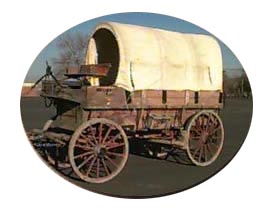Heritage Gateways
Official Sesquicentennial K-12 Education Projectsponsored by the Utah State Board of Education, the BYU-Public School Partnership and the Utah Education Network
Pioneer 1848-1868 Companies
1848-60, Mormon Emigrants (Stan Kimball Info.)

Image courtesy of: Heritage Gateway Project Images, These images have been gathered to support the Sesquicentennial celebration of the immigration to Utah.
The main difference between the pioneers of 1846-1847 and subsequent Mormon emigrants was that each year the trek became a little easier as a result of experience, established (and enforced) discipline, better roads, ferries, bridges, and the ever-increasing number of trailside services like blacksmithing, medical assistance, military installations, trading establishments, and the telegraph.
Another big difference between the early companies of 1847-1848 and subsequent parties is that once the trail was well established and trail routine and discipline fixed, the leadership of post-1848 companies was turned over to lower-level leaders and even to missionaries returning from their fields of labor. Young and Kimball, for example, never led any immigrating companies after 1848.
Still another difference was the use of trail variants such as those developed in southern Iowa, or via Mitchell Pass in Nebraska, not crossing the Platte River at Fort Laramie in Wyoming, and many Oregon Trail variants. Post-1847 Mormons even used entirely different trails.
Between 1846-1853, Mormons infrequently used the Dragoon Trail between Montrose, Iowa, to what is now Des Moines, Iowa. Between 1849-1859 they sometimes traveled the Ox-Bow Trail, a variant of the Oregon Trail, which extended from Nebraska City, Nebraska, to Fort Kearny on the Platte. Then from 1860 to about 1866, Mormons infrequently used the Nebraska City Cutoff Trail, another variant of the Oregon Trail, which replaced the older Ox-Bow Trail, from Nebraska City to Fort Kearny. A few Mormons, between 1846 and about 1853, also used the little-known-today Trappers" Trail between Bent's Fort, in what is now Colorado, on the Arkansas River, to Fort Laramie on the North Platte. During the 1850s and 1860s some Mormons also traveled The Overland Trail from near what is now Sidney, Nebraska, to Fort Bridger. A major trail variant even appeared in Utah. This was the Golden Road, a 42-mile-long variant of the original Mormon Trail in Utah. Between 1850 and 1869, many Mormons preferred this variant, which left the 1847 trail at the mouth of Emigration Canyon and entered Salt Lake City via Parley's Canyon.
Source: Historic Resource Study - Mormon Pioneer National By Stanley B. Kimball, Ph.D., May 1991. (The study focuses on the history of the trail from its official beginning in Nauvoo, Illinois, to its terminus in Salt Lake City, Utah, during the period 1846-1869. During that time, thousands of Mormon emigrants used many trails and trail variants to reach Utah. This study emphasizes the "Pioneer Route" or "Brigham Young Route" of 1846-1847. The sections on Mormon beliefs and motivations for going west have been omitted. Interested persons can find ample sources for that information. The footnotes, bibliography, maps, pictures, pioneer companies by name and dates for the 22-year period, and historic sites - about 2/3 of the book - have also been left out for space considerations. Thanks to Dr. Kimball and the National Park Service for the availability of this information.)